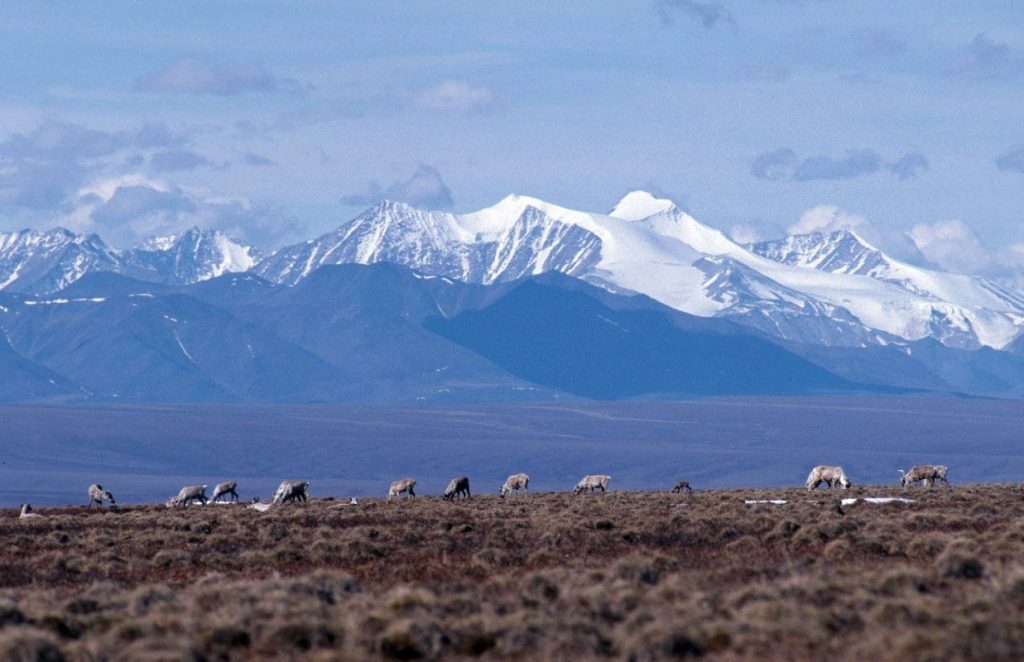Continued warming could make Alaska’s Arctic refuge even more crucial for calving caribou
A new study found that the Arctic National Wildlife Refuge will offer better calving and post-calving habitat in a warmer future, while the quality of Yukon habitat will decline.

The coastal plain of the Arctic National Wildlife Refuge is so important to the Porcupine Caribou Herd that the Indigenous Gwich’in people of the region call it “Iizhik Gwats’an Gwandaii Goodlit,” meaning “the sacred place where life begins.”
And now, a new study by Alaskan and Canadian scientists finds that as the Arctic continues to warm and snowmelt and plant green-up advance, that area is set to become even more heavily used in summer by the caribou herd — a herd which spans the U.S.-Canada border and which has been at the center of a decades-long debate over oil development in the refuge.
The study, published in the journal Global Change Biology, used information from movements of radio-collared caribou tracked between 2012 and 2018 and matched those movements to conditions on the ground, as recorded by satellite imagery.
It found a clear pattern: When snowmelt and green-up are earlier in spring, the caribou tended to stick to the Arctic refuge’s coastal plain for calving. When snowmelt and green-up are later, the caribou are more likely to give birth to their young in Canada’s Yukon Territory to the east of the Alaska border.
With the climate warming, the areas in Alaska considered suitable caribou habitat is projected to increase from present levels by 115 percent by the 2050s — and by 429 percent within the 1002 Area, the specific part of the Arctic Refuge coastal plain that has been targeted for oil development, the study projected. On the other hand, the area in Yukon likely to be suitable calving habitat is expected to decrease by 31 percent by the 2050s, and there will be almost no suitable post-calving habitat in Yukon by then, according to the study projections.
“In the future, we project that that distribution will shift a little bit further north and a little bit further west to include more of the 1002 Area,” said U.S. Geological Survey wildlife biologist John Severson, the first author of the study.
The study period was too short to show a long-term trend, but it did include plenty of variation that showed how responses differ according to weather conditions, said USGS biologist Heather Johnson, a co-author. In 2015, there was “an incredibly early spring, a record-early spring,” while in 2018 the spring snowmelt and green-up were particularly late, she said.
The fate of the Porcupine Caribou Herd — one of the largest in North America with 218,000 animals at last count — is a key part of the debate over oil development in the refuge.
The herd is known for its migration pattern that sends dense crowds of caribou each summer into the relatively narrow wedge of northeastern Alaska land between the Brooks Range mountains and the Arctic Ocean, putting it into the territory that development supporters believe could produce millions of barrels of new oil.
The herd migrates in a counter-clockwise pattern, sweeping north from the Brooks Range into Yukon and then over the border to Alaska. That migration pattern is determined by the availability of food, Johnson said. Since snow-off and green-up happen first in Yukon, the caribou head there first before moving west into Alaska, she said.
Much of what makes territory right for caribou calving and post-calving grazing was revealed by the study. It found that preferred sites for giving birth to caribou are places where the snow had melted several days prior, likely where there were open islands of new vegetation within larger areas still holding snow. For the post-calving period, the caribou selected habit where snow had melted 20 to 40 days earlier and where the plants had turned green 10 to 20 days earlier, the study found. During the post-calving period, the study found, plants appear to be at their ideal stage as caribou food when they are midway to maximum greenness measured by satellite as the Normalized Difference Vegetation Index, or NDVI.
Exactly what plants the caribou prefer to eat during calving and post-calving is still an open question, Johnson said. “Right now we have folks in the field collecting data so they can answer that,” she said. For about nine months of the year, the caribou diet is mostly lichen, she said. But for the brief summer, they have other plants available — forbs, grasses and small shrubs — and scientists are examining fecal pellets to try to better understand the summer diet mix, she said.
The outcome of the debate over ANWR oil development also remains undetermined.
In its last days, the Trump administration auctioned off leases within the refuge coastal plain and transferred nine of them to bidders, none of which were major oil companies. There has been no on-the-ground exploration activity. The Biden administration opposes oil development there, and Interior Secretary Deb Haaland on June 1 suspended the leases, barring any activity on them until a more complete environmental review is performed.
Also blocking exploration activity are four lawsuits pending in U.S. District Court in Anchorage that that challenged the Trump administration leasing program. The lawsuits filed by environmentalists, indigenous tribes and organizations and several Lower 48 states.
The Biden administration is still considering how to resolve those lawsuits. In a status report filed Friday, the Department of the Interior asked for an extension of the pause, through at least Sept. 9, “so that Defendants can determine their position regarding the nature of, or need for, further litigation,” which would be informed by the new comprehensive environmental analysis.
Meanwhile, legislation pending in Congress would void that requirement and grant wilderness status to the 1002 Area coastal plain, the same protective status that exists elsewhere in the refuge.